GOOSE, any of numerous large, mainly grazing species of waterfowl closely related to swans and ducks. Nearly all geese are found in the north temperate and Arctic zones, and virtually all are migratory.
There are at least 15 species and many more subspecies of true geese. Together with swans and ducks, they make up the family Anatidae of the order Anseriformes.
Geese are usually intermediate in size between swans and ducks. They also differ from their relatives in feeding habits. Swans are adapted for foraging in water on aquatic vegetation, and ducks have comparatively Hat bills adapted for straining plant or animal matter from water; neither are adapted for clipping terrestrial vegetation, or grazing, as are geese. intermediate types occur, however. For example, numerous species of sheldrakes in South America and Africa seem to occupy an intermediate position between true geese and ducks in their natural relationships and their ecological adaptations. The socalled maned goose (Chenonetta jubata) of Australla is really a duck having a gooselike bili. Several species of pygmy geese (Nettapus species) of the African, Asian, and Australlan tropics are also really ducks.
Description and Distribution.
Geese tend to vary gready in size and coloring in different parts of their ranges. all, however, have short legs, webbed feet, and rather short, straight bills. They also all have a heavy layer of down and are covered with dense plumage as are all waterfowl.
Black Geese.
Several species of geese, including the Canada goose (Branta canadensis), the brant goose (B. bernicla), and the Hawaiian goose (B. sandvicensis), are known collectively as “black geese.” They are all predominantly black in the head and neck regions, and all have black bili and foot coloring.
The Canada goose ranges over most of the interior of North America. In early pioneer days, a “giant” type of Canada goose was found nesting on the Great Plains. An adult frequently weighed more than 16 pounds (7.2 kg) and occasionally more than 20 pounds (9 kg), making it the largest of all wild geese. This population has become virtually extinct as a result of shooting and habitat changes, but a small remnant of the race stili exists in refuges and a few other areas. In contrast, various tiny Canada goose types, such as the darkcolored cackling Canada goose (B. c. mirıima) of the far western areas and Richardson’s Canada goose (B. c. hutchinsii) of the interior, breed along the Bering Sea and Arctic Ocean. Adults of these populations usually weigh bctween 3 and 4 pounds (1.31.8 kg) and vary from dark brown to relatively pale gray. There are several Canada goose races that are intermediate in size between these two extremes.
The brant goose is a familiar species found along the east and west coasts of North America. The Hawaiian goose is, however, rare. Known locally as the nene, it is seldom found on water and is unusual among geese in that it does not migrate but inhabits the barren lava slopes of the Hawaiian islands the year round.
Gray Geese.
Geese that generally have gray or white heads, brownish to grayish or white bodies, and yellow, red, or multicolored feet and bills are known as “gray geese.” The most familiar of the gray geese is the common barnyard goose. It was derived from the greylag goose (Anser anser) — a graycolored species that lags behind other geese during migration and remains to nest in the temperate regions of Europe and Asia.
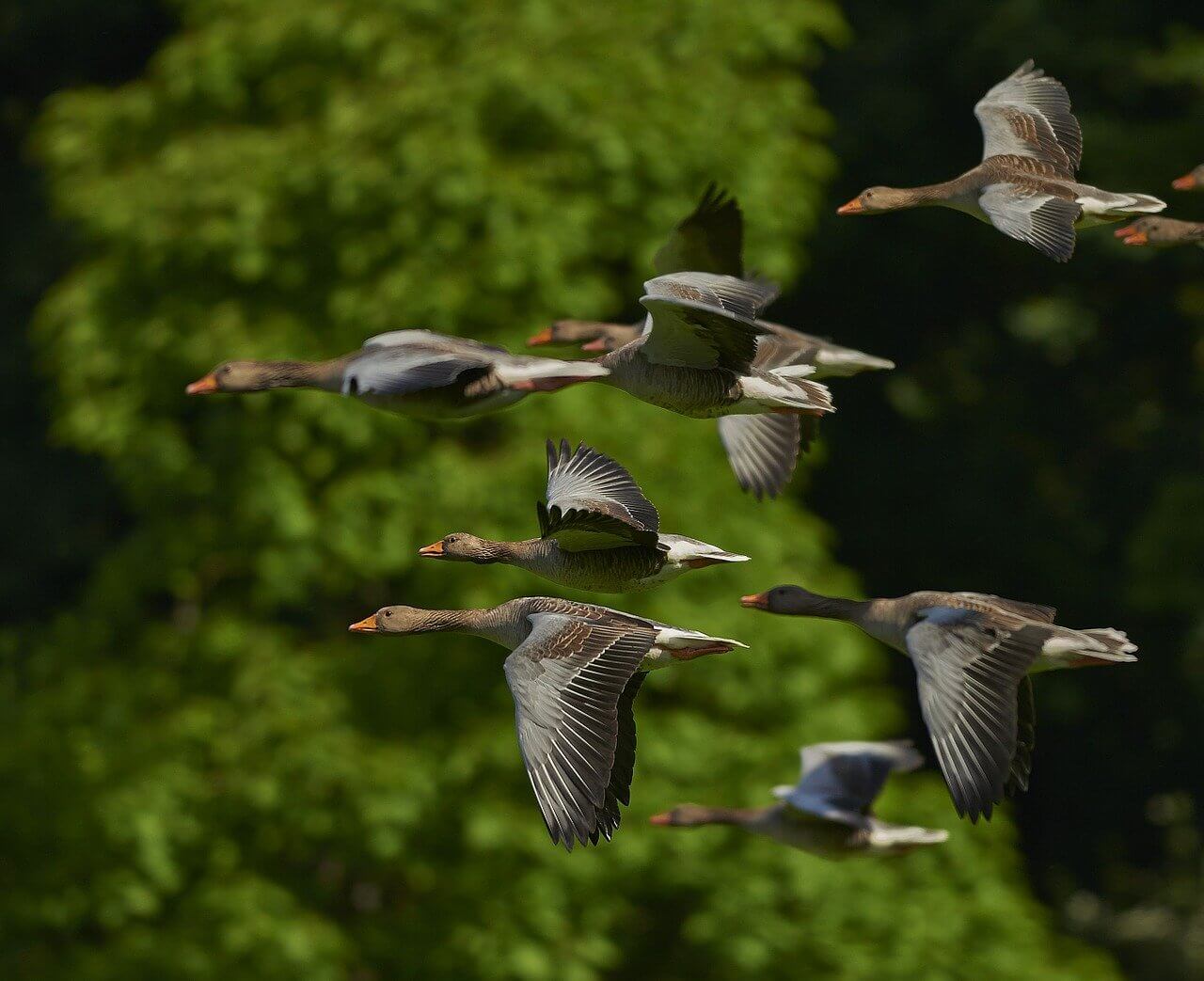
Source: pixabay.com
The whitefronted goose (Anser albifrons) is another gray goose. It nests in North America, Europe, and Asia, and thus has the widest geographical distribution of any goose. Other North American species of gray geese include the Arcticbreeding snow and blue geese (Chen caerulescens); the tiny 3pound (1.3 kg) Ross’s goose (Chen rossii), which resembles a miniature snow goose and is the smallest North American goose; and the rare emperor goose (Philacte canagica) of Alaska and Siberia, which the Eskimo use extensively for food and feathers.
The snow and blue geese illustrate the remarkable variation of waterfowl. Although they have been traditionally recognized and are stili technically regarded as two distinct species, it has long been known that birds intermediate in appearance between the two often occur. Such birds have been regarded as hybrids, but their relative abundance makes such an explanation inadequate. Studies on the Arctic breeding ground have revealed that the blue goose is actually only a plumage variant or color phase of the snow goose. Although it differs genetically in this regard from the snow goose and has slightly different ecological adaptations that favor its survival and reproduction in subarctic breeding conditions, the blue goose readily mates with the snow goose, and their offspring apparently survive as well as either of the pure types.
Behavior.
Geese are highly gregarious at all times other than when nesting, and a few, such as the blue and snow geese, even form massive nesting colonies. Such flocks are made up of thousands of individual family units that remain fairly well intact within the flock; family members apparently can recognize each other without difficulty. The whole flock can instantly respond to the warning calls of a few birds and will be airborne in a matter of seconds. If time allows, the geese toss their heads a few times before takeoff to warn other birds in the vicinity of their imminent departure. On taking off, geese need more space or more of a headwind than do ducks, and geese typically run a few steps along the ground or over the water before attaining their minimum flight speed.
Life Cycle.
All geese have similar life cycles. They are normally monogamous and, like swans, form strong pair bonds that typically last through the entire adult life of the pair. If one member of the pair dies or the pair becomes permanently separated, however, a new mate is likely to be taken in time.
Geese mature in their second or third year. In the wild it is probable that most females begin nesting when nearly three years old, although a few may initially nest earlier in their second year. Once mature, geese regularly breed once a year.
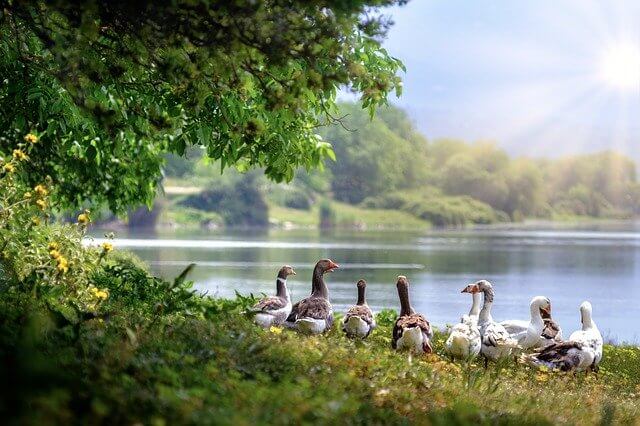
Source: pixabay.com
Nesting and Incubation.
Male geese, or ganders, establish nesting territories, which they strongly defend against intrusion by other geese and sometimes even by other larger animals. Females locate nest sites within this large territory. The nests may be simple or bulky, depending on the species, and they may be on shore, amid reed beds, or on muskrat houses. all geese line their nests with a mixture of breast feathers and down that serves to insulate the eggs and possibly makes them less conspicuous.
Four to seven eggs are laid at one or twoday intervals. Although the female may spend considerable time on the nest during the egglaying period, she pays little attention to the eggs until the last one is laid. She then begins intensive incubation, which lasts from 21 to 30 days, depending on the species. The male remains near the nest during the incubation period and will vigorously defend it from disturbances.
Development of the Young.
After incubation is complete, the eggs begin “pipping”; that is, the young gosling, using a sharp “egg tooth” near the tip of its bili, gradually chips a circular hole around the blunt end of the egg. About 24 hours after such “pipping,” the gosling thrusts itself out of the shell, and its down begins to dry and form a fluffy coat.
The female and goslings usually remain on the nest for the first day after hatching. This assures that any late “pipping” young will survive and that the brood will be well rested from their hatching efforts before leaving the safety and comfort of the nest. Soon the mother goose and gander lead the brood from the nest to forage for small animal life in the protected shallows of the pond or marsh. At short intervals, the family returns to shore, where the young huddle under the parents’ wings.
Within 40 to 85 days, depending on the species, the young develop sufficienuy to bemn flying. While the young learn to fly, the flijpıt feathers and other plumage of the adults undergo their yearly renewal. By the time the brood is two or three months old, both the youngsters and the adults are ready to migrate to winter quarters.
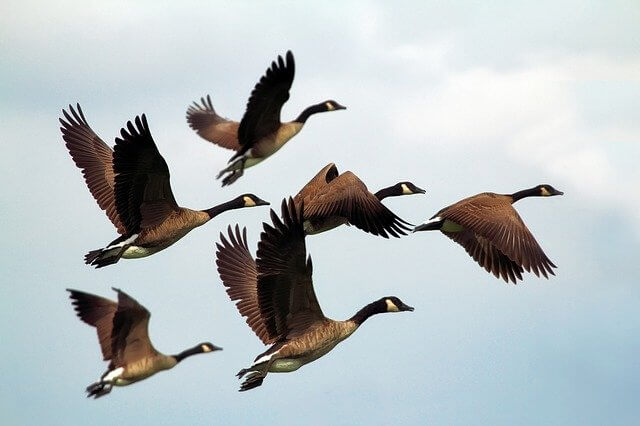
Source: pixabay.com
Life Span.
Many younger and inexperienced birds fail prey to predators, hunters, or other causes of death during their first year, but most goose families remain relatively intact throughout their wintering and migration periods. When they return to the breeding grounds in spring, the yearling birds separate from the adult breeders and usually spend the summer months well apart from the nesting birds.
Geese are potentially quite longlived. In captivity they have often been known to survive for 20 or 30 years. Wild geese, however, have typically shorter lifespans, and a bird that has survived for as long as 10 years in the wild would be most unusual.
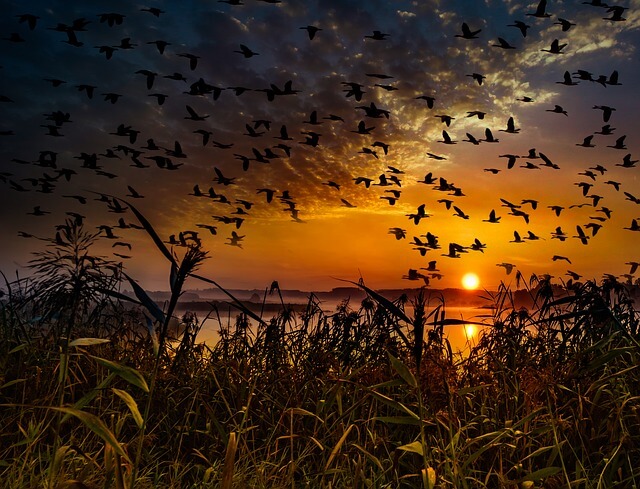
Source: pixabay.com
Migration and Navigation.
While migrating, geese often fly in a wedge, or V, formation, sometimes at elevations of several thousand feet. Contrary to popular opinion, the lead bird of the V formation is not always an adult male; rather, the geese shift their relative positions frequently during the flight. The V flight formation provides maximum visibility and prevents air turbulence caused by one member of the flock from disturbing other flock members.
Geese may migrate either at night or during the day. Wind direction and relative cloudiness are important factors afl’ecting migration. On clear days or starry nights, the birds evidently use the position of the sun or constellations as guidelines for navigational purposes and thus need not rely on remembered landmarks for their movements. Experiments with various birds in planetariums have proved their starnavigational ability beyond doubt.
However, memory certainly plays an important part in the selection of stopover points during migration, and flocks will return year after year to favored locations. This behavior accounts for the great success of the refuge system in waterfowl management, and the resulting spectacular concentrations of geese and other migratory water birds that periodically build up in such areas. On some refuges the goose population may increase to half a million birds for a short time, only to decline rapidly to alnıost none as the birds push on in their migratory urge to reach some final destination.
Value and Domestication.
The wariness of wild geese has made goose hunting a popular and challenging sport. The keen eyesight and hearing sense of geese have also long been used by man. The ancient Egyptians, Romans, and Greeks kept captive geese both as a source of food and as sentries that could be counted upon to raise the alarm when disturbed.
The most widely domesticated goose is the greylag, which has given rise to such domestic forms as the Embden, Roman, Toulouse, and Sebastopol varieties. An Asian gray goose called the swan goose (Anser cygnoides) has also been domesticated and developed into such types as the Chinese and African varieties, both of which have distinctive forehead knobs. Domesticated geese, which are much heavier than wild species, have almost entirely lost their ability to fly.
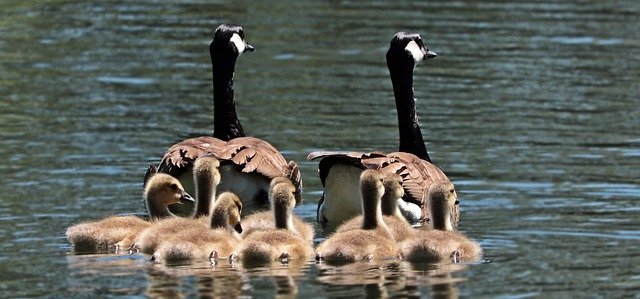
Source: pixabay.com
At one time a fighting variety of greylag goose, called the Russian goose, was specifically bred for game fights, but this breed gradually disappeared when the sport was generally prohibited. Now most geese are reared for food, although their feathers and especially the down are valuable as insulating materials in bedding and clothing. Various domesticated varieties such as the Sebastopol goose are sometimes raised for ornamental purposes, and many people now rear wild varieties of geese and other waterfowl as a hobby or for sale to zoos or bird fanciers. The keeping of wild geese and other nondomesticated waterfowl is regulated by law.
Conservation of Wild Geese.
Through intelligent management by both the United States and Canada, the populations of most wild geese in North America are in good condition. Wintering areas and migration resting points are kept safe, and breeding grounds are protected from serious disturbance or destruction. As a result, the populations of many species of geese are perhaps larger than they were a century ago. Since most of these species nest in relatively inaccessible and unspoiled tundra areas, they have not suffered from much habitat change and breeding area destruction. Even in parts of Alaska and Canada where adult geese and goose eggs provide an important part of the diet of the Eskimo, the populations of geese are generally large. So long as the northern breeding grounds can be preserved from excessive human influences, the geese of mainland North America should remain fairly secure.
Less optimistic statements must be made for the Hawaiian goose, which was virtually extinct during the 1950’s and has since been saved only by the intensive efforts of conservationists. Another goose—the Bering Canada goose of the Commander Islands—apparently became extinct in the early 1900’s and a closely related Aleutian Islands race is extremely rare.